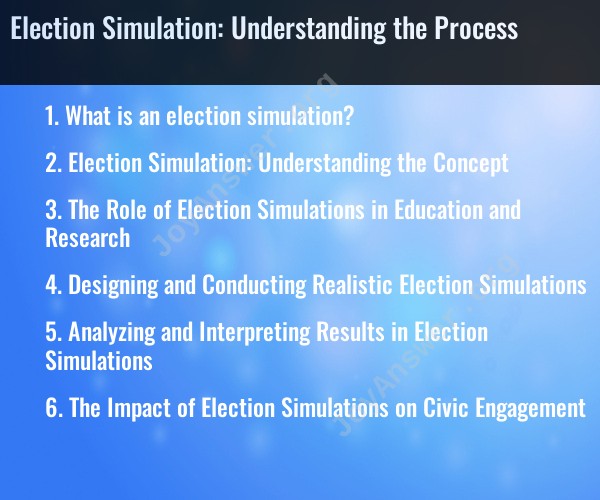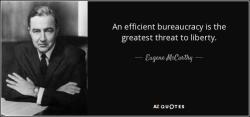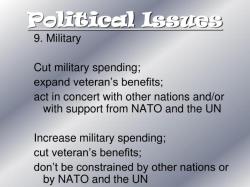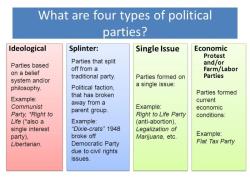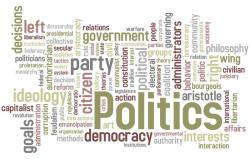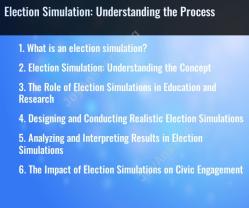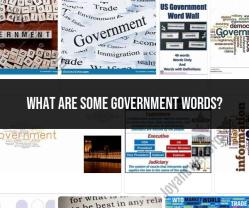What is an election simulation?
An election simulation is a process or activity that mimics the procedures and dynamics of a real election. It is typically used for educational, training, research, or analysis purposes to help participants better understand the electoral process, practice decision-making, or study the potential outcomes of an election. Election simulations can take various forms, depending on their objectives and the level of detail they aim to replicate. Here are some key aspects of election simulations:
Purpose: Election simulations are conducted for a variety of purposes, such as teaching students about the democratic process, training election officials, analyzing potential election outcomes, or conducting research on voting behavior.
Participants: Participants in an election simulation can vary widely, from students in a classroom setting to election officials, political scientists, or experts conducting research.
Scope: Simulations can cover different levels of elections, from local or municipal elections to national or even international elections. The scope can also include primary elections, general elections, or specific types of elections, such as presidential or parliamentary elections.
Simulation Methods: There are several methods for conducting election simulations, including role-playing, computer-based simulations, tabletop exercises, and mock elections. Each method has its own advantages and may be tailored to the specific objectives of the simulation.
Role-Playing: In role-playing simulations, participants take on various roles, such as candidates, voters, election officials, or campaign strategists. They make decisions and interact with others as they would in a real election.
Computer-Based Simulations: Computer programs can simulate election scenarios, allowing participants to make decisions, campaign, and see the simulated results based on the rules programmed into the software.
Tabletop Exercises: These are group activities where participants discuss and plan responses to various election-related scenarios and challenges. Tabletop exercises can help election officials prepare for real-life contingencies.
Mock Elections: Mock elections involve voting by participants to simulate the electoral process. These can be simple or complex, depending on the level of detail and authenticity desired.
Data Analysis: Some election simulations involve data analysis and modeling to predict election outcomes, study voting behavior, or test the impact of various factors on the results.
Learning and Analysis: The primary goals of election simulations are often education and analysis. Participants can learn about the electoral process, political strategies, and the complexities of running an election. Researchers and analysts can study the impact of various variables on election outcomes and voter behavior.
Election simulations are a valuable tool for enhancing understanding of the electoral process, conducting research, and preparing election officials for real-world challenges. They can help identify potential issues and improve election procedures, and they often serve as a safe environment for learning and experimentation.
Election Simulation: Understanding the Concept
An election simulation is a model of the real-world election process. It can be used to educate voters, train election officials, or test new voting technologies. Election simulations can be simple or complex, and they can be conducted in a variety of settings, from classrooms to polling places.
The Role of Election Simulations in Education and Research
Election simulations can be used to teach voters about the election process and to help them understand their choices. They can also be used to train election officials on how to conduct elections efficiently and accurately. Additionally, election simulations can be used by researchers to study the impact of different factors on election outcomes, such as voter turnout, campaign strategies, and media coverage.
Designing and Conducting Realistic Election Simulations
When designing and conducting an election simulation, it is important to consider the following factors:
- The purpose of the simulation: What do you want participants to learn or experience?
- The target audience: Who are you designing the simulation for?
- The level of realism: How closely do you want the simulation to match the real-world election process?
- The resources available: What resources do you have in terms of time, money, and personnel?
Once you have considered these factors, you can begin to develop your simulation plan. This should include identifying the specific tasks that participants will complete, the materials they will need, and the steps that will be taken to ensure the accuracy and fairness of the simulation.
Analyzing and Interpreting Results in Election Simulations
Once your election simulation is complete, you will need to analyze and interpret the results. This may involve calculating voter turnout, tallying votes, and determining the winner. You may also want to survey participants to get their feedback on the simulation and to learn what they learned.
The Impact of Election Simulations on Civic Engagement
Election simulations can have a positive impact on civic engagement by:
- Increasing voter knowledge and understanding of the election process: Election simulations can help voters to learn about the different types of elections, the candidates and issues on the ballot, and the voting process.
- Encouraging voter participation: Election simulations can help to motivate voters to participate in elections by making the voting process more accessible and engaging.
- Building civic skills and knowledge: Election simulations can help voters to develop civic skills such as critical thinking, problem-solving, and decision-making.
Overall, election simulations are a valuable tool for educating voters, training election officials, and conducting research. They can also be used to promote civic engagement and participation.
Here are some examples of how election simulations are being used today:
- Schools: Many schools use election simulations to teach students about the election process and to encourage them to become civically engaged.
- Nonprofit organizations: Nonprofit organizations often use election simulations to educate voters and to promote voter turnout.
- Election officials: Election officials may use election simulations to train poll workers and to test new voting technologies.
- Researchers: Researchers may use election simulations to study the impact of different factors on election outcomes.
Election simulations can be a powerful tool for promoting democracy and civic engagement.
